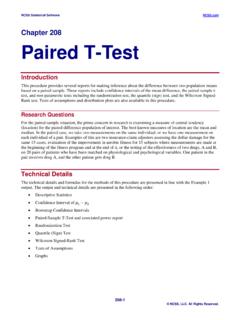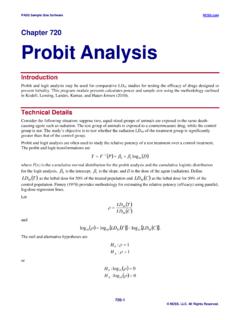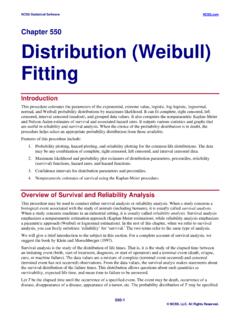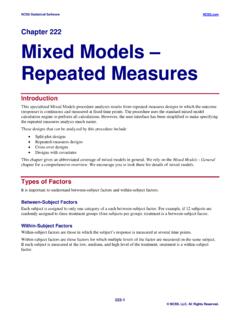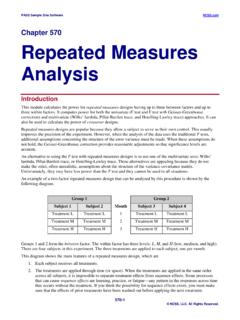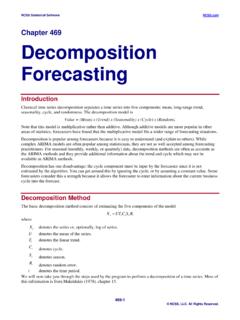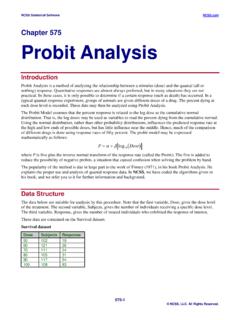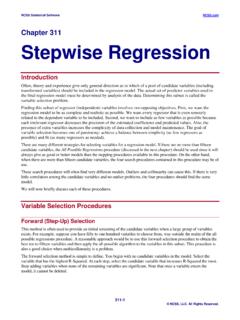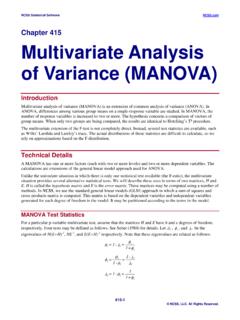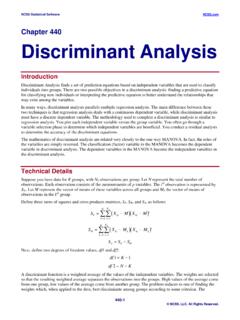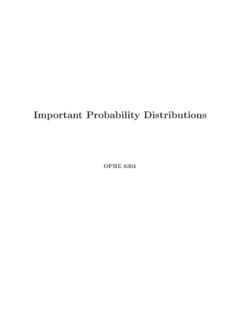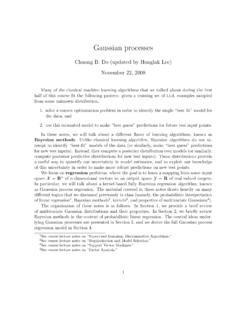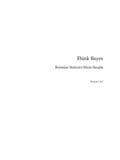Transcription of Chapter 194 Normality Tests - NCSS
1 NCSS Statistical Software 194-1 NCSS, LLC. All Rights Reserved. Chapter 194 Normality Tests Introduction This procedure provides seven Tests of data Normality . If the variable is normally distributed, you can use parametric statistics that are based on this assumption. If a variable fails a Normality test, it is critical to look at the histogram and the normal probability plot to see if an outlier or a small subset of outliers has caused the non- Normality . If there are no outliers, you might try a transformation (such as, the log or square root) to make the data normal. If a transformation is not a viable alternative, nonparametric methods that do not require Normality may be used. Always remember that a reasonably large sample size is required to detect departures from Normality .
2 Only extreme types of non- Normality can be detected with samples less than fifty observations. There is a common misconception that a histogram is always a valid graphical tool for assessing Normality . Since there are many subjective choices that must be made in constructing a histogram, and since histograms generally need large sample sizes to display an accurate picture of Normality , preference should be given to other graphical displays such as the box plot, the density trace, and the normal probability plot. Normality Tests generally have small statistical power (probability of detecting non-normal data) unless the sample sizes are at least over 100. Technical Details This section provides details of the seven Normality Tests that are available.
3 Shapiro-Wilk W Test This test for Normality has been found to be the most powerful test in most situations. It is the ratio of two estimates of the variance of a normal distribution based on a random sample of n observations. The numerator is proportional to the square of the best linear estimator of the standard deviation. The denominator is the sum of squares of the observations about the sample mean. The test statistic W may be written as the square of the Pearson correlation coefficient between the ordered observations and a set of weights which are used to calculate the numerator. Since these weights are asymptotically proportional to the corresponding expected normal order statistics, W is roughly a measure of the straightness of the normal quantile-quantile plot.
4 Hence, the closer W is to one, the more normal the sample is. The probability values for W are valid for sample sizes greater than 3. The test was developed by Shapiro and Wilk (1965) for sample sizes up to 20. NCSS uses the approximations suggested by Royston (1992) and Royston (1995) which allow unlimited sample sizes. Note that Royston only checked the results for sample sizes up to 5000, but indicated that he saw no reason larger sample sizes should not work. W may not be as powerful as other Tests when ties occur in your data. The test is not calculated when a frequency variable is specified. Anderson-Darling Test This test, developed by Anderson and Darling (1954), is a popular among those Tests that are based on EDF statistics.
5 In some situations, it has been found to be as powerful as the Shapiro-Wilk test. Note that this test is not calculated when a frequency variable is specified. NCSS Statistical Software Normality Tests 194-2 NCSS, LLC. All Rights Reserved. Martinez-Iglewicz Test This test for Normality , developed by Martinez and Iglewicz (1981), is based on the median and a robust estimator of dispersion. The authors have shown that this test is very powerful for heavy-tailed symmetric distributions as well as a variety of other situations. A value of the test statistic that is close to one indicates that the distribution is normal. This test is recommended for exploratory data analysis by Hoaglin (1983). The formula for this test is: ()Ixxnsiinbi = = 2121() where sbi2 is a biweight estimator of scale.
6 Kolmogorov-Smirnov Test This test for Normality is based on the maximum difference between the observed distribution and expected cumulative-normal distribution. Since it uses the sample mean and standard deviation to calculate the expected normal distribution, the Lilliefors adjustment is used. The smaller the maximum difference the more likely that the distribution is normal. This test has been shown to be less powerful than the other Tests in most situations. It is included because of its historical popularity. D Agostino Skewness Test D Agostino (1990) describes a Normality test based on the skewness coefficient,b1. Recall that because the normal distribution is symmetrical, b1 is equal to zero for normal data. Hence, a test can be developed to determine if the value of b1 is significantly different from zero.
7 If it is, the data are obviously non-normal. The statistic, zs, is, under the null hypothesis of Normality , approximately normally distributed. The computation of this statistic, which is restricted to sample sizes n>8, is zdTaTas=+ + ln21 where bmm1= 3223 Tbnnn=++ 11362()()() Cnnnnnnnn=+ ++ +++327701325)(792()()()()()() WC2121= + () aW= 212 dW=1ln() NCSS Statistical Software Normality Tests 194-3 NCSS, LLC. All Rights Reserved. D Agostino Kurtosis Test D Agostino (1990) describes a Normality test based on the kurtosis coefficient, b2. Recall that for the normal distribution, the theoretical value of b2 is 3. Hence, a test can be developed to determine if the value of b2 is significantly different from 3. If it is, the data are obviously non-normal.
8 The statistic, zk, is, under the null hypothesis of Normality , approximately normally distributed for sample sizes n>20. The calculation of this test proceeds as follows: zAAGAAk= + 12912124291 3/ where bmm2= 422 Gbnnn nnnnn= + +++223312423135)()()() ()( Ennnnnnn nn= +++++ 65279635)232()()()()(()() AEEE= ++ + 682142 D Agostino Omnibus D Agostino (1990) describes a Normality test that combines the Tests for skewness and kurtosis. The statistic, K2, is approximately distributed as a chi-square with two degrees of freedom. After calculated zs and zk, calculate K2 as follows: Kzzsk222= + Data Structure The data are contained in a single variable. Height dataset (subset) Height 64 63 67 .. NCSS Statistical Software Normality Tests 194-4 NCSS, LLC.
9 All Rights Reserved. Procedure Options This section describes the options available in this procedure. To find out more about using a procedure, turn to the Procedures Chapter . Following is a list of the procedure s options. Variables Tab The options on this panel specify which variables to use. Data Data Variable(s) Specify a list of one or more variables upon which the Normality Tests are to be generated. You can double-click the field or single click the button on the right of the field to bring up the Variable Selection window. Frequency Variable This optional variable specifies the number of observations that each row represents. When omitted, each row represents a single observation. If your data is the result of a previous summarization, you may want certain rows to represent several observations.
10 Note that negative values are treated as a zero weight and are omitted. Break Variables Break Variables You can select up to five categorical-break variables. When one or more of these are specified, a separate set of reports is generated for each unique set of values for these variables. Box-Cox Power Transformations Exponent Occasionally, you might want to obtain a statistical report on the square root or logarithm of your variable. This option lets you specify an on-the-fly transformation of the variable. The form of this transformation is X = YA, where Y is the original value, A is the selected exponent, and X is the value that is summarized. Additive Constant Occasionally, you might want add a constant to each value so that no zero or negative values occur.
